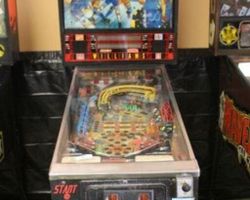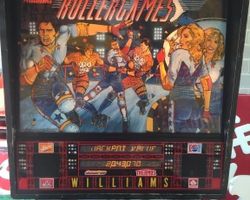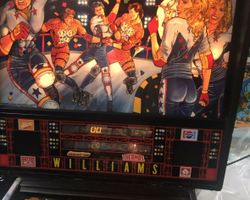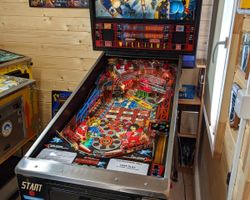Rollergames
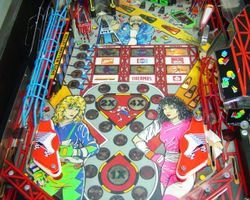
Average Prices: USD $500 to $1,500
Produced: April, 1990
Machine Type: Solid State Electronic
MPU: Williams System 11C
Players: 4
Design by: Steve Ritchie
Art by: Pat McMahon
Mechanics by: Carl Biagi
Music by: Dan Forden
Sound by: Dan Forden
Software by: Mark Penacho
Williams Electronic Games, Inc. introduced Rollergames to pinball players in June 1990, capturing the energetic, if brief, spirit of the roller derby television show from which it derived its name. The machine, running on the robust Williams System 11C, emerged from a creative period for the manufacturer, known for producing engaging and technically innovative games. Despite the television series’ cancellation before the pinball machine's production truly ramped up, the development team pushed forward, delivering an experience that remains distinctive.
The design of Rollergames was led by Steve Ritchie, a designer known for creating fast-paced, high-flow pinball layouts. His influence is evident throughout the playfield, emphasizing quick returns and continuous action. Pat McMahon contributed the vibrant artwork for both the playfield and the backglass, infusing the machine with the distinct visual flair of late 1980s and early 1990s aesthetics. Linda Deal provided the backbox art, further cementing the machine’s visual identity. The auditory landscape of Rollergames was crafted by Dan Forden, who composed the catchy, sometimes addictive, musical scores and sound effects. Mark Penacho handled the software, ensuring the various mechanics and scoring systems operated cohesively. Carl Biagi engineered the mechanical aspects, translating design concepts into physical reality. Steve Ritchie himself lent his voice to some of the game’s callouts, delivering memorable lines, while the female voice acting and music vocals were provided by local talent, contributing to the machine’s unique sonic character. Approximately 5,000 units of Rollergames were produced, making it a significant release for Williams, even with the backdrop of its licensed theme’s uncertain future.
Signature Features and Design
Rollergames is characterized by several standout elements that define its gameplay and aesthetic. Central to its unique mechanics is the ball-catching magnet positioned at the tip of the upper right flipper. This magnet works in conjunction with "The Pit," a saucer located just left of the playfield’s center. When a ball lands in "The Pit" and the magnet is activated, the game instructs the player, "Don't Flip!" A VUK (Vertical Up-Kicker) then fires the ball up through a wireform, directly in front of the upper flipper, where it is momentarily held by the magnet. The game then cues, "Flip!", prompting the player to precisely time a shot up "The Wall" ramp, a critical scoring opportunity. This "Don't Flip! FLIP!" sequence is a signature interaction, adding a layer of controlled chaos and strategic timing to the gameplay.
Another defining feature is "The Wall," a steep ramp that serves as a primary shot for multiball initiation and jackpot collection. Balls locked for multiball descend a wireform ramp to a capture area. Once two balls are locked, and the lock is lit, they eject, traveling around a circular wireform ramp over the playfield before returning to the capture area, building anticipation for the multiball start. Completing the three-ball lock unleashes the dynamic three-ball multiball, where hitting "The Wall" becomes the paramount objective for high scores. The left outlane is equipped with a two-stage kickback mechanism, an innovative design that shoots the ball straight up a small ramp, onto another kicker not otherwise in play, and finally around an orbit, returning it to the upper right flipper area. This kickback provides a crucial save, adding depth to outlane management. The playfield also incorporates three spinners, providing satisfying auditory and tactile feedback as the ball races through their pathways. The overall design emphasizes a bright, energetic aesthetic, featuring detailed artwork by Pat McMahon that integrates the roller derby theme with a vibrant, neon-infused palette, complementing the machine's fast-paced nature.
Playfield and Mechanics
The Rollergames playfield is meticulously laid out to encourage a fast, flowing game, characteristic of Steve Ritchie’s design philosophy. At the bottom, three flippers provide primary control: two at the traditional lower position and one strategically placed upper right flipper dedicated to launching balls up "The Wall" ramp. The left outlane is protected by a two-stage kickback, which can be relit by hitting the 'ABC' standup targets on the right side of the playfield. The left inlane lights the right Jetway, initiating potential scoring bonuses.
On the left side of the playfield, a bank of 'SKATE' standup targets, upon completion, lights 'WILLIAMS' and activates the crucial magnet feature. Above these targets is the left Jetway, an orbit shot with a spinner, contributing to combo opportunities. Near the center, "The Pit" acts as a saucer, offering various awards such as Roller Motion, Magnet activation, and Scoring Cycle. Dominating the upper center is "The Wall," a steeply angled ramp designed for Jackpot, Lock, and Million shots, with multiple exits that direct the ball around the playfield, maintaining flow. Below "The Wall" are three '123' center standup targets, which light the Roller Motion award. To the right of center, a bank of 'WAR' drop targets (which were standup targets in most production units, a change from earlier prototypes) serves as the primary mechanism for locking balls in single-ball play, essential for initiating multiball.
The upper right flipper leads directly to "The Wall" ramp, making it a critical shot. Adjacent to this flipper is the unique magnet, which captures the ball for timed ramp shots. The right side of the playfield mirrors some of the left’s elements, featuring a right Jetway with a spinner and the 'ABC' standup targets. The top of the playfield includes 'JET' rollover lanes, which advance the bonus multiplier, encouraging players to aim for these lanes to maximize end-of-ball bonuses. Throughout the playfield, the artwork by Pat McMahon is a visual spectacle, depicting dynamic roller derby action figures and bold, graphic elements. The lighting design works in concert with the artwork, with bright inserts and flashers illuminating key shots and modes, enhancing player immersion and signaling game progression.
Gameplay Dynamics
The core objective in Rollergames revolves around achieving a high score through a combination of strategic shot-making, mode progression, and mastering the exhilarating multiball. Points accumulate by hitting various targets, ramps, and orbits, but the overarching goal is to initiate multiball and subsequently hit "The Wall" for lucrative jackpots.
A key strategic element is the ball lock mechanism. Players must repeatedly hit the 'WAR' drop targets (or standup targets on most production machines) to lock three balls, triggering multiball. During multiball, the focus shifts to hitting "The Wall" ramp, which is typically lit for the jackpot, providing a significant boost to the score. Another unique sequence is activated by "The Pit" saucer, which grants "Roller Motion" awards, offering various in-game bonuses and setting up the critical magnet shot. When the magnet is lit, hitting "The Pit" triggers the "Don't Flip! FLIP!" sequence, a moment of suspense followed by a precise shot opportunity up "The Wall," often leading to high-value awards.
Rollergames also features a "WILLIAMS Scoring Cycle," a hurry-up mode initiated after completing the 'WILLIAMS' sequence on the left standup targets. This mode requires quick execution to collect a declining score before time runs out. The game also includes a random "Sudden Death" round during single-ball play, challenging players to hit "The Wall" for an immediate score. Combo shots are encouraged, particularly shooting the left Jetway followed by "The Wall" ramp, which awards escalating points for successful sequences. Power Plays can be earned by hitting "The Wall" when no other awards are lit, and collecting enough Power Plays lights Extra Balls and Outlane Specials, adding another layer of strategic depth. The bonus multiplier, advanced by hitting the 'JET' rollover lanes at the top of the playfield, encourages players to manage their ball control to maximize end-of-ball scores. The game’s memorable custom speech callouts and catchy background music, featuring distinct tunes for different modes (standard, two-ball lock, multiball, "go for the wall," and jackpot), contribute significantly to the immersive and fast-paced gameplay experience.
Reception and Legacy
Rollergames has received varied feedback within the pinball community, often categorized as an underrated machine or a hidden gem from the Williams System 11 era. Its strengths are frequently highlighted, particularly its fast-paced and exciting gameplay. Many players praise the machine's flow, emphasizing the continuous action that keeps the ball moving rapidly around the playfield. This kinetic energy, combined with straightforward rules, often makes it accessible and fun for both beginners and experienced players.
The standout magnet mechanic, especially the "Don't Flip! FLIP!" sequence, is consistently lauded as a unique and satisfying feature, adding a moment of anticipation and skill to the game. Hitting "The Wall of Death" ramp is a universally satisfying shot, particularly when it leads to a jackpot during multiball. The unique ball lock mechanism, with its looping wireform, also contributes to the game's distinctiveness. Pinball enthusiasts often point to the catchy and memorable music by Dan Forden, particularly the main theme and the energetic "Kick Butt!" jackpot tune, along with the game’s custom speech callouts, as elements that enhance the atmosphere and contribute to its addictive quality. The integrated theme, despite its cheesy nature for some, is often seen as well-executed within the gameplay, evoking a sense of 80s/90s nostalgia. The bright lights and dynamic light show further contribute to its engaging presence.
However, Rollergames is not without its detractors. Some players find the roller derby theme and the accompanying artwork, particularly the backglass, to be dated or aesthetically unappealing, which can initially deter interest. While many appreciate the straightforward rules, others perceive them as too simple or lacking in depth, leading to a feeling of repetitiveness over extended play. Specific criticisms include the game's perceived over-reliance on multiball as the primary scoring mechanism and the random nature of the "Sudden Death" mode, which some find frustrating. Technical issues, such as the magnet being unreliable on some machines or "The Pit" VUK interrupting the flow of play, are occasionally cited. Despite these criticisms, Rollergames maintains a generally positive reputation. Its legacy is tied to the System 11 era, showcasing Steve Ritchie's signature fast flow and innovative mechanical features. While perhaps not a monumental game in pinball history, it remains a notable example of its time, appreciated for its raw speed, engaging features, and highly replayable qualities, solidifying its place as a valued machine within the collections of enthusiasts who appreciate its particular brand of high-energy fun.
Sponsored Links
 Ebay Listings
Ebay Listings
 Auction Results
Auction Results
| Cost | Location | Date |
|---|---|---|
| USD $2,300 |  Minnesota, United States Minnesota, United States |
26 October, 2025 |
| USD $3,200 |  Oregon, United States Oregon, United States |
04 May, 2024 |
| USD $3,100 |  New Hampshire, United States New Hampshire, United States |
01 May, 2024 |
| USD $4,995 |  Ohio, United States Ohio, United States |
21 March, 2024 |
| USD $4,995 |  Ohio, United States Ohio, United States |
09 March, 2024 |
| USD $2,650 |  Minnesota, United States Minnesota, United States |
05 February, 2024 |
| GBP £1,400 |  United Kingdom United Kingdom |
20 January, 2024 |
| GBP £1,950 |  Chelmsford, United Kingdom Chelmsford, United Kingdom |
04 October, 2023 |
| USD $2,800 |  Minnesota, United States Minnesota, United States |
06 April, 2023 |
| USD $2,500 |  Pennsylvania, United States Pennsylvania, United States |
04 March, 2023 |


Private Policy · Search Website · Contact Us
As an eBay Partner, we may earn a commission from qualifying purchases made through links on this site, at no additional cost to you.
All trademarks and copyrighted materials remain property of their respective owners. All other content copyright 2007 - 2025 Pinpedia.

